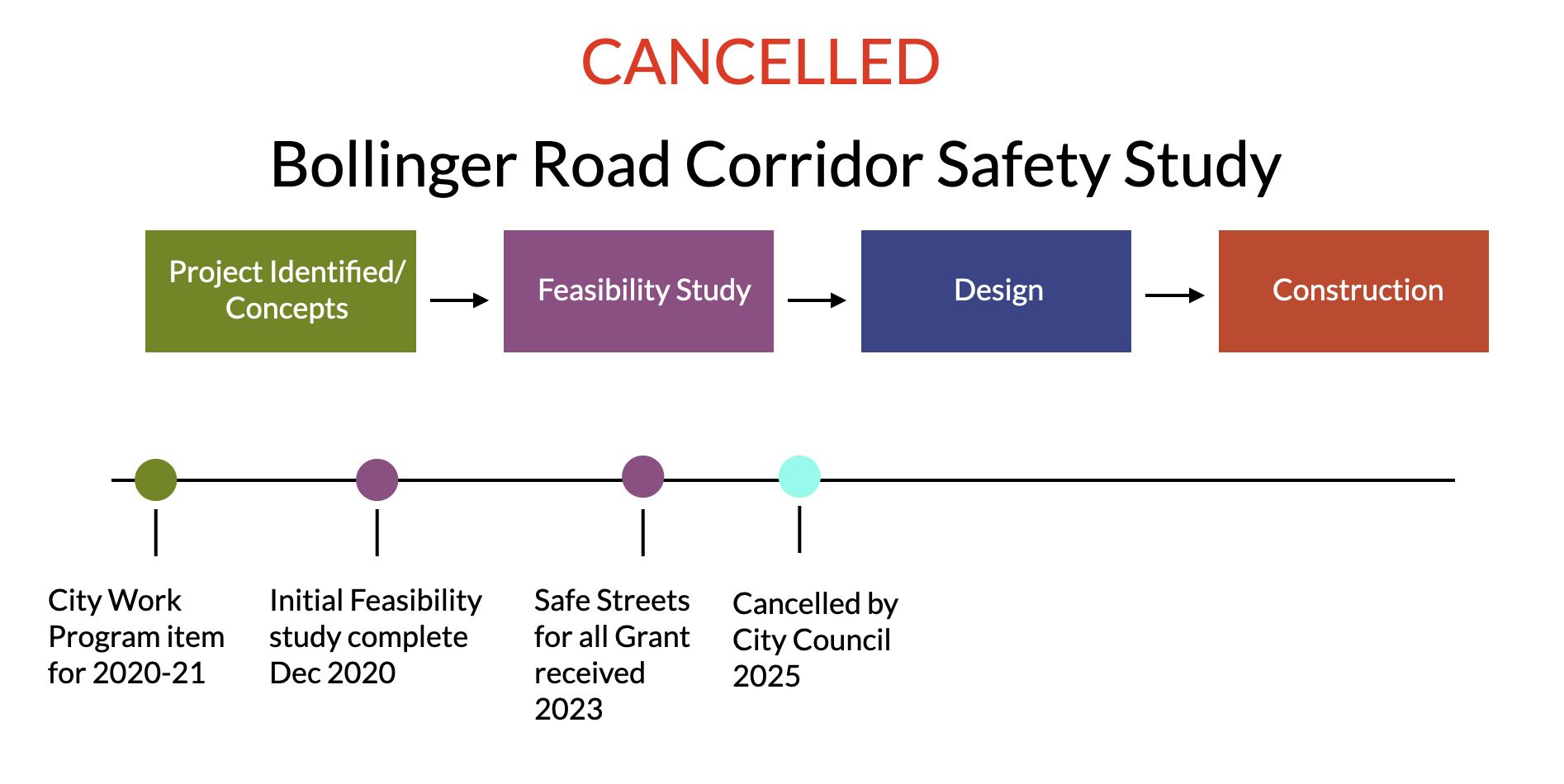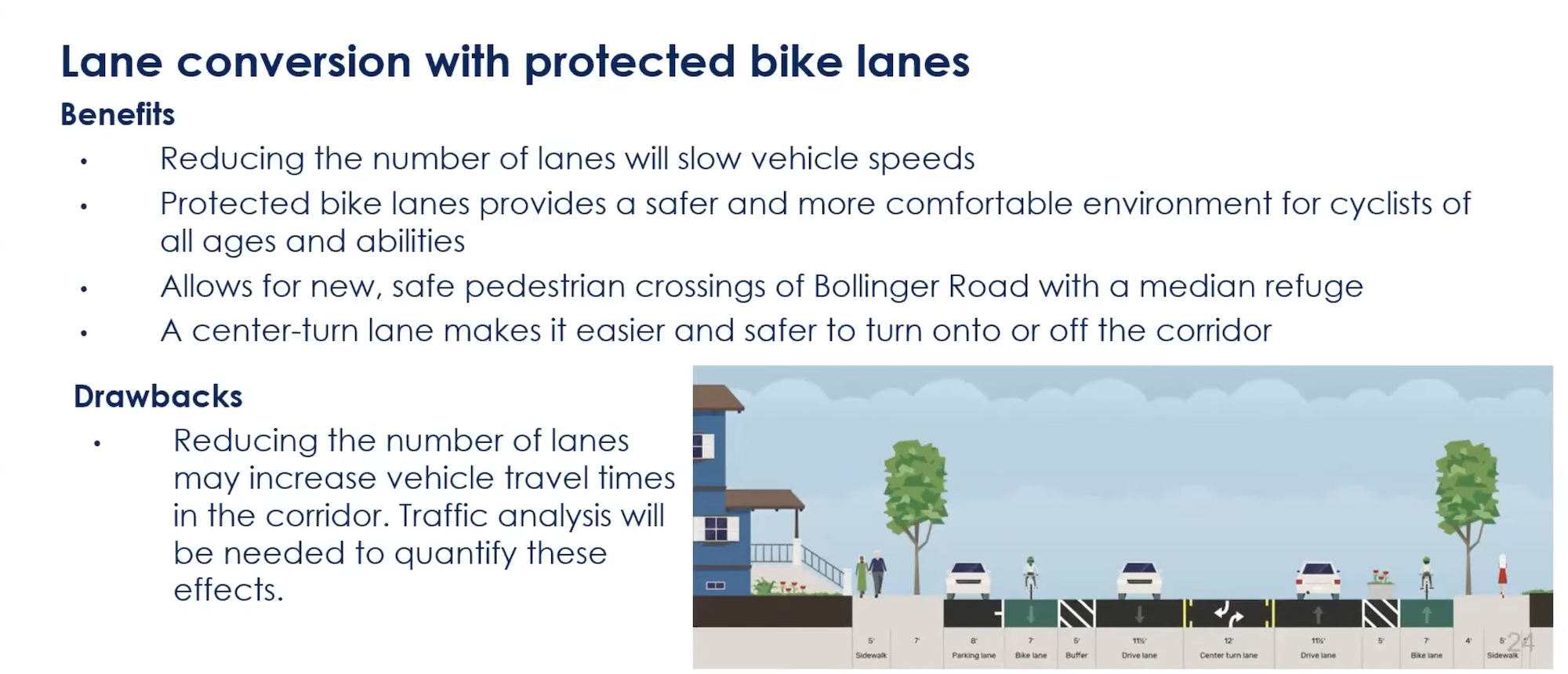Key Facts About the Bollinger Road Corridor Safety Study
Cost: $532K total, $106K city General Fund, $442K grant. Implementation costs of any plan will be funded separately ($4 million estimate).
Project: Study Bollinger Road from De Anza Boulevard to Lawrence Expressway to identify improvements that will enhance pedestrian, bicycle, motor-vehicle, and transit operations and safety.
Type of Project: Study/Designs
Current Status (September 2025):
This project has been cancelled by the City Council.
The project was initiated as this corridor was identified in Cupertino’s Vision Zero and Local Road Safety Plans as a high-injury and high-fatality/severe injury corridor.
Further study was needed beyond a small study completed in December 2020 on potential improvements. The additional work included a topographic and utilities survey of Bollinger Road, preliminary engineering and final design, and traffic analysis. Only after further study would alternatives for potential changes be presented to the Cupertino City Council. Any potential changes would be in coordination with San Jose.
The city council in June 2025 decided on a 3-1 (1 recused) vote to end the study on the basis of “driver’s rights” and fear that proposals to reduce fatalities and serious injuries would slow car traffic. [See here for the full analysis of the meeting where this safety study was killed, along with rejecting the associated grant funding.]
Project Overview
Study Bollinger Road from De Anza Boulevard to Lawrence Expressway to identify improvements that will enhance pedestrian, bicycle, motor-vehicle, and transit operations and safety. These could include improved crossings, a road diet, RRFBs, Hybrid Beacons, tightening curb radii, eliminating free right turns in some locations, relocating bus stops, adding bike boxes, improved lighting, and more.
2020 Study
As part of the 2020 study, an analysis of existing conditions and a summary of past collisions along the corridor was conducted. This was followed by an online outreach portal that gathered public input on location-specific improvement needs along the corridor. The portal gave the users the ability to provide their input through means of a general survey as well as a “social pinpoint” map where users provided location specific input using an online mapping tool. This outreach portal was distributed by City of Cupertino and City of San Jose staff through each City’s respective social media pages on Facebook, Twitter, Instagram, and Next Door as well as working groups such as Walk Bike Cupertino, Bicycle-Pedestrian Commission, and Safe Routes to School. Users were able to provide their input over a course of three weeks.
The responses and suggestions provided in the first round of outreach were used to guide concept development. Based upon results from the existing conditions analysis and the public survey, specific improvements were identified that would address the challenges the corridor presents. Two alternatives were created to reflect different priorities and strategies for improving the corridor:
- Alternative A includes a road diet where the road would be reduced to one travel lane in each direction, including the provision of a center two-way left turn lane.
- Alternative B maintains the existing lane configuration while providing spot improvements, primarily at intersections.
On May 19, 2021, a virtual neighborhood meeting was held to discuss these improvement concepts. Notifications were sent to residents and those who responded during the first round of outreach. Methods of outreach for this event were similar to those used during the first round of public outreach. The meeting included a presentation introducing the study, explaining the existing conditions, summarizing the first round of outreach, and then explaining both proposed concepts along with their key attributes and differences. The meeting also included an interactive discussion session where attendees were able to provide written or verbal questions.
2024 Update
Grant funding now allows the further design and analysis work required. This includes a topographic and utilities survey of Bollinger Road, preliminary engineering and final design, and traffic analysis. The traffic analysis would determine the potential for the road diet (Alternative A) to increase congestion or divert traffic onto residential streets, and any corresponding mitigation measures to limit that impact. Community outreach efforts should continue in future project phases to ensure community awareness and support of the project.
The study was cancelled by the newly installed City Council after six months of their tenure in June 2024, based upon fears that car traffic would be slowed if any changes were made to improve the safety along the corridor. The grant to cover 80% of the cost of the study was rejected and returned to the federal government.
Why Does Walk-Bike Cupertino Support this Project?
.
Bollinger Road has documented safety issues, including fatalities
The corridor has been an area of concern in the Local Road Safety Plan (LRSP) as a high-injury corridor and also listed as a recommended area for improvement based on its high number of KSIs per Cupertino’s Approved Vision Zero Plan (approved July 9, 2024 by the City Council). These issues need addressing to make this a safe corridor to use for all transportation users, whether by car, bike, walking, or transit. This study will determine the most effective way to address the concerns.
Narrowing lanes to add protected bike lanes, one possibility for this corridor, has been shown to improve traffic flow.
A Johns Hopkins study from 2023 of over 1100 streets in seven cities shows that’s not the case. The number of crashes on a street with standard 12-foot lanes is significantly higher than on streets with narrower 9 foot lanes at the typical city 30-35mph speed limits. “On streets that are busier, have trees, lots of pedestrians, a bike lane, and bikes on the street, drivers feel less safe driving fast and will drive slower, regardless of the speed limit.” A slower speed of cars also substantially reduces the risk of crashes, per the same study.
A road diet, which is one possibility for this corridor, has been shown through studies to improve emergency response time.
Some examples are this study from the University of Iowa in 2024, and this study in 2024 from Transportation Research Interdisciplinary Perspectives.
The two alternatives currently being discussed for Bollinger Road
Option 1: Protected bike lanes along the corrider.
One travel lane in each direction, with a center turn lane. Allows for beacons to allow pedestrians to cross at several locations along the corridor, and maximizes their protection.
Option 2: Two vehicle travel lanes in each direction (as today), bicycles get buffered lane where possible.
RRFB Beacons to allow pedestrians to cross at one location, Hybrid (overhead) beacons at two locations, if warrant studies allow.
How Walk-Bike Cupertino has actively supported this project
Walk-Bike Cupertino has:
Met with City Staff, Bicycle Pedestrian Commission, and Cupertino City Councilmembers to discuss details of the project and to encourage progress and encouragement of walking and biking enhancements for the creation of a new plan.


